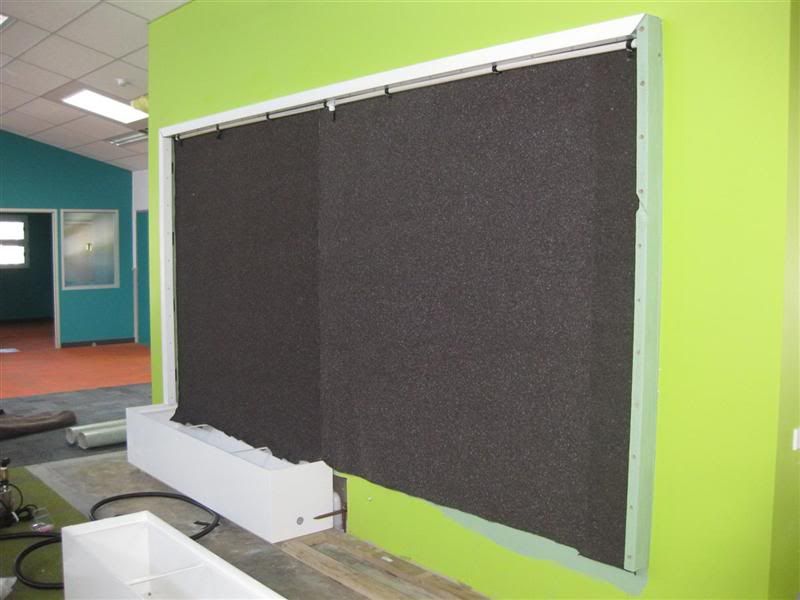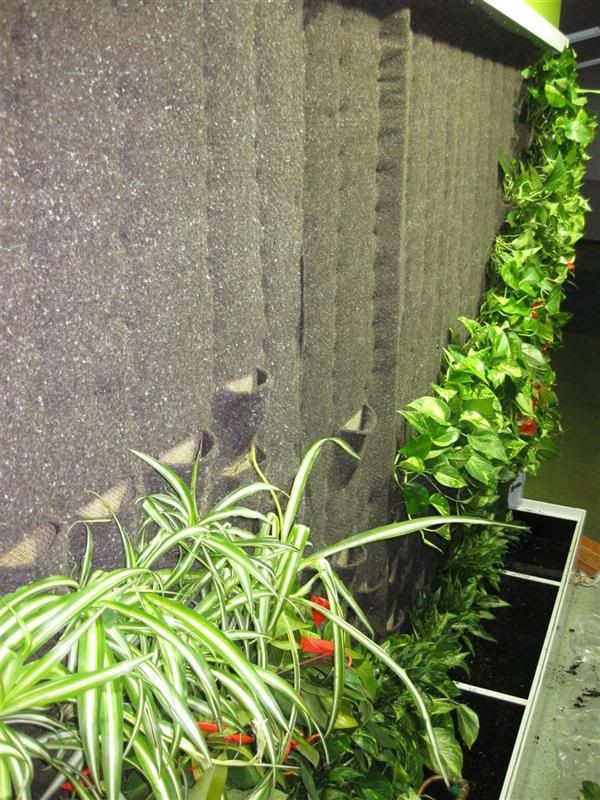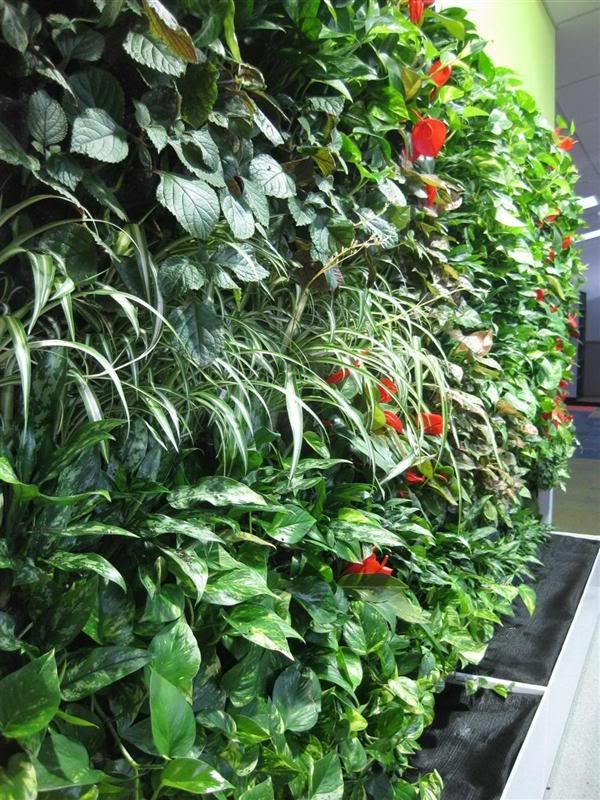donderdag 19 november 2015
Postzegel parken
http://www.postzegelparken.nl/
woolly pocket
Miguel Nelson of Woolly Pocket
November 5, 2009
The path to a better world isn't through pavers but via plants, says artist and Woolly Pocket
founder Miguel Nelson. "I love architecture but I think if everyone was
gardening instead of building, things would be better. I think we were
put on Earth to garden."

Brothers and Woolly Pocket co-founders Rodney and Miguel Nelson pose in front of their Woolly Wall Pockets on display at Flora Grubb Gardens in San Francisco.Photo by Lance Shows
A self-described "late bloomer" when it came to finding his green thumb, Nelson watched his wife learn to garden and when it came time to cover the walls of the event spaces he owns in Los Angeles with his brother, Rodney, they created pockets in which to grow plants and hang on the walls. "So many people came to the spaces and kept saying how much they liked them and would like to have some," he says. "One day, we realized that we had invented a product and should probably start selling it."
The brothers founded Woolly Pocket in January 2009 and launched the online store a few months later in May. Since then, Nelson has teamed up with School Nutrition Plus to install edible gardens in public schools throughout Los Angeles and is working with the city to create community gardens in blighted areas of L.A. and to green the downtown core. Dwell associate editor Miyoko Ohtake spoke with Nelson about the company's products and projects.
To see more Woolly Pockets and images from the School Nutrition Plus-Woolly Pocket edible gardens, view the slideshow.
Dwell how make totally green wall
http://www.dwell.com/outdoor/article/how-make-totally-green-wall#1


zaterdag 3 oktober 2015
lucy mirror
https://vimeo.com/136671174?from=outro-embed

Lucy is an intelligent solar-powered robotic mirror that reflects sunlight to the same spot indoors or out by following the Sun and repositioning itself throughout the day. Lucy can provide a unique lighting solution for the home or office, even in places without power.
The device was developed by Diva Tommei, CEO of Solenica, who developed Lucy to combat seasonal affective disorder.
Lucy, An Intelligent Solar-Powered Mirror That Reflects Sunlight to the Same Spot All Day by Following the Sun
by Glen Tickle|October 1, 2015

Lucy is an intelligent solar-powered robotic mirror that reflects sunlight to the same spot indoors or out by following the Sun and repositioning itself throughout the day. Lucy can provide a unique lighting solution for the home or office, even in places without power.
The device was developed by Diva Tommei, CEO of Solenica, who developed Lucy to combat seasonal affective disorder.
Biomodd
source:http://www.urbangardensweb.com/2015/09/24/hybrid-art-project-creates-symbiosis-between-plants-and-computers/?utm_medium=referral&utm_source=pulsenews
http://www.biomodd.net/
Hybrid Art Project Creates Symbiosis Between Plants and Computers
September 24, 2015 by Robin Plaskoff Horton
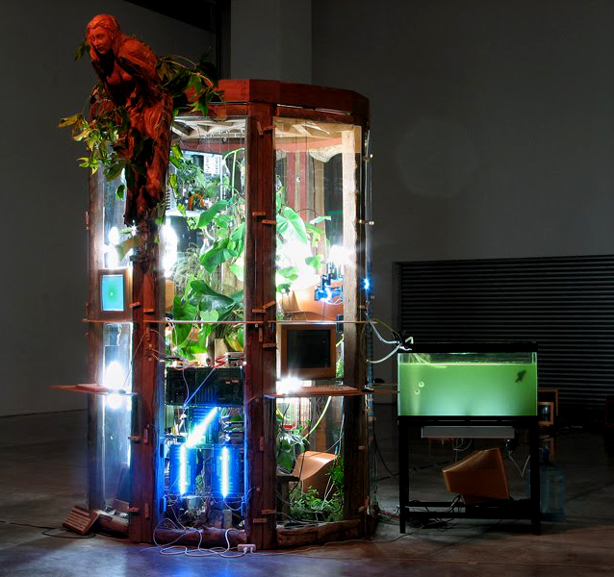
Throughout much of history, art and science have co-existed in a symbiotic and synergistic relationship. Inquiry, experimentation, and observation lead to creative works in both the studio and the laboratory. A modern-day example of this melding of the two is Biomodd, a multifaceted socially engaged art installation which lives at the intersection of art, biology, and technology.
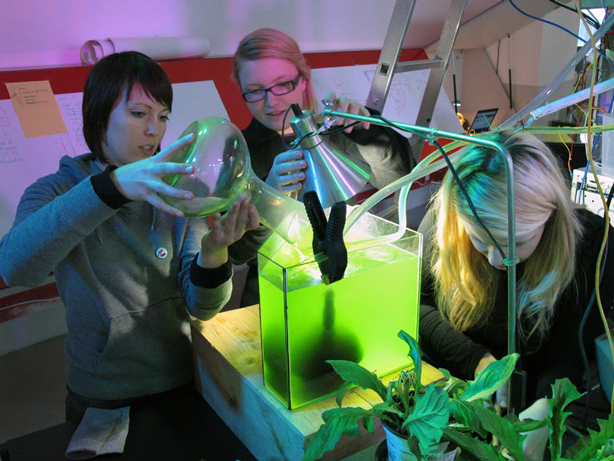
A nomadic open source project conceived by Belgian biologist-turned-artist and Senior TED Fellow, Angelo Vermeulen, Biomodd explores meaningful relationships between biology, computers and people. “On the most basic level,” explains Vermeulen, “Biomodd creates symbiotic relationships between plants and computers, and ignites conversations among the community around them.”
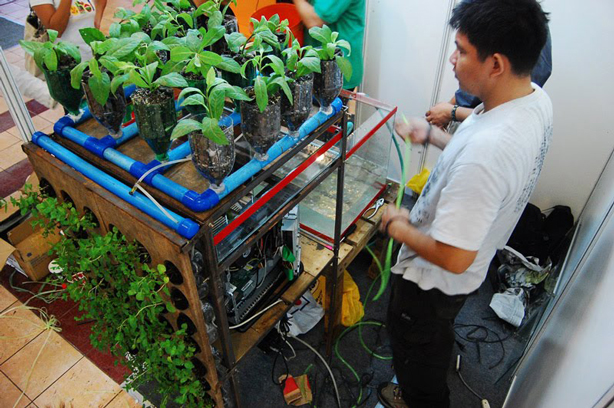
Algae, Computers, and Plant-Based Ecosystem
Bridging science and art, Vermeulen and fellow collaborators use algae to cool computer processors, allowing the machines to run faster, utilizing the heat generated by the computer’s electronics to create ideal growing conditions for a plant-based ecosystem.
This dynamic is the catalyst for co-creation efforts throughout the world between a core team composed of artists, biologists, computer scientists, game designers, gardeners, community organizers, and members of the local community in which the project is experienced.
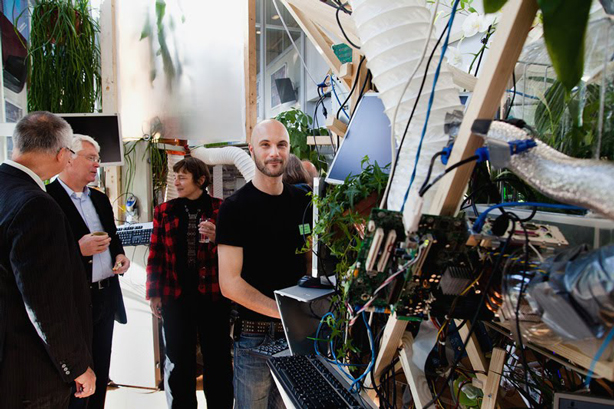
Multi-Faceted Collaborative and Co-creative Effort
Collaboration and co-creation, integral to the Biomodd project, functions on two levels. Teams work together yet every individual within the group is empowered to add something substantial to the work. The project begins with a solely conceptual focus, then grows organically from there then gets recreated in different locations throughout the world, each time with different people.
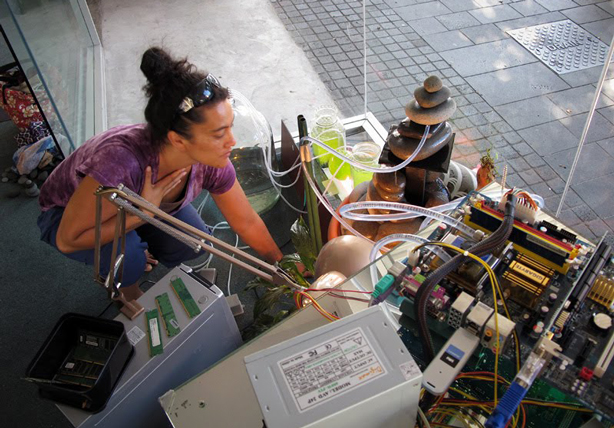
Operating Beyond Boundaries of Contemporary Art
Biomodd’s primary inspiration and impetus, Case Modding–a practice where people modify their PCs into functional works of art–is, according to the artists, “an active and creative subculture which operates way beyond the boundaries of contemporary art.”
Biomodd explores this user-led modification concept from an artistic perspective, transforming electronic-based computer systems into plant-based ecosystems. Approaching the work as a form of “expanded sculpture,” they build structures which are both functioning computer and living sculptures, co-opting the computer’s functionality by recycling the heat it emits to create an ecosystem inside an electronic structure.
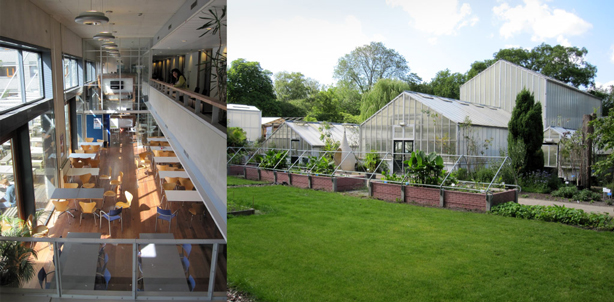 Left. in Netherlands, TU Delft’s Faculty of Technology
Policy and Management where Biomodd will be developed. Right: Botanical
garden. Photo via Biomodd.
Left. in Netherlands, TU Delft’s Faculty of Technology
Policy and Management where Biomodd will be developed. Right: Botanical
garden. Photo via Biomodd.Gaming the Ecosystem
The gaming culture and digital games are integral to each Biomodd installation. Each exemplifies the social nature of gaming and game culture, functioning as a fully enabled gaming station for multi-player games.
From the Artist Statement:
“Biomodd was conceived to challenge presumed notions of opposition between nature and technology in different cultures throughout the world. In Biomodd, nature and technology are not juxtaposed but rather fused into imaginative hybrid installations. The core idea is the creation of experimental systems in which modified computer networks coexist with living ecosystems. The challenge is to bring biological life as physically close to the electronics as possible, and allow them to communicate with each other through meaningful symbiotic relationships.”
The Biomodd Conceptual Framework
Each project is predicated on a set of themes:
1. Symbiosis between biological and electronic systems.
2. E-waste and its creative reuse.
3. Case modding.
4. Digital games and gaming culture.
5. Juxtaposition of local and global.
6. Open sourcing.
The Biomodd Circuit
Biomodd debuted in Athens, Ohio in 2007, and various version of it have since traveled to the Philippines, Slovenia, New Zealand, Belgium, the Netherlands, New York, Germany, Kosovo, and now London. Biomodd [ATH1] in Athens, Ohio was built between September 2007 and January 2008, and was nominated for the Prix Ars Electronica Hybrid Art award in 2008. The more monumental second iteration, Biomodd [LBA2], was created in Los Baños, Philippines between February and October 2009 and was co-led by Angelo Vermeulen and Diego Maranan. In 2010, after completion of Biomodd [LBA2], Angelo was granted a TED Fellowship in part because of his work on the Biomodd series.
In 2011 during Biomodd [TUDelft3] in the Netherlands augmented reality was implemented for the first time by Pieter Steyaert. Introductory Biomodd workshops have been conducted in Sint-Niklaas (Belgium), Maribor (Slovenia), and New Plymouth (New Zealand). Independent Biomodd projects have been built in the Philippines and Slovenia – led by Al Librero, Maruša Novak and others. Currently a new full-scale Biomodd version is under development at NYSCI in New York City, and in 2014 Biomodd will set foot in London.
All photos via Biomodd.
woensdag 16 september 2015
EPDM rubber platen als ondergrond
http://www.rubbermagazijn.nl/collectie/rubber-matten/rubberplaat/2013_zwart_rubberplaat-9mm-plaat-100x100cm.html
zaterdag 5 september 2015
Kinglake Vertical Garden
http://lushe.com.au/regeneration-wall/
Kinglake Vertical Garden
On 7 February 2009, The ‘Black Saturday’ bushfires destroyed the Middle Kinglake Primary School, as well as surrounding schools in Strathewen and Marysville. The Black Saturday bushfires were a series of bushfires that were burning across the Australian state of Victoria and resulted in Australia’s highest ever loss of life from a bushfire. 173 people died as a result of the fires and 414 were injured. Lushe were proud to be involved in the reconstruction effort.
Lushe’s Technical Manager, Josh Engwerda described the project “It was great to be involved in the reconstruction effort and be able to provide of a centre piece for the school”.
The wall was completed using 12mm marine ply followed by a water proof coating. The felt material chosen was made of 100% recycled plastic bottles, PET, and won’t rot or degrade with time.
Pockets were cut into the felt just large enough to hold the plants while keeping them nice and close together to give the wall an instant dense look
The plants were arranged in horizontal layers to accentuate the contrasting colours, textures and sizes of the differing foliage and flowers.
The felt was stapled every 10-15cm to create the required plant density.
The lights used were three 150W metal halides, the bluish colour of the light is perfect for foliage growth in most plants.
OSA Architects are leading the design of the reconstruction effort at Kinglake Primary Schoo. Geoff Stanistreet, Director, wanted a living wall for not just aesthetic reasons but to also assist in providing better quality air by processing the Co2.
OSA uses many ESD initiatives in its projects mindful of reducing recurrent energy costs to clients whilst providing comfortable indoor environments. Passive cooling and heating is foremost in our designs using products such as Smartroof roof air management systems and good passive design principals.
The plant list includes Syngonium spp, Aglaonema spp, Pothos devils ivy and Anthurium Schirzrianum to name a few.
The water reservoir and pump ensure the plants are well watered and then that water is collected and reused.
Lushe wish the rest of the Kinglake and surrounding communities the best in continuing with their reconstruction effort and rebuilding their lives. Lushe would also like to thank the support provided by the City of Melbourne for assisting with a grant for business development and expansion.
reconstructing rotterdam
http://lushe.com.au/reconstructing-rotterdam/
Reconstructing Rotterdam
Came accross this cool vertical garden design from a blog post with title Reconstructing Rotterdam. Dont have much more information besides that, but it looks very interesting. It certainly makes the ugly building look a lot more attractive
A Van Gogh as green wall painting
http://lushe.com.au/a-wheatfield-with-cypresses/
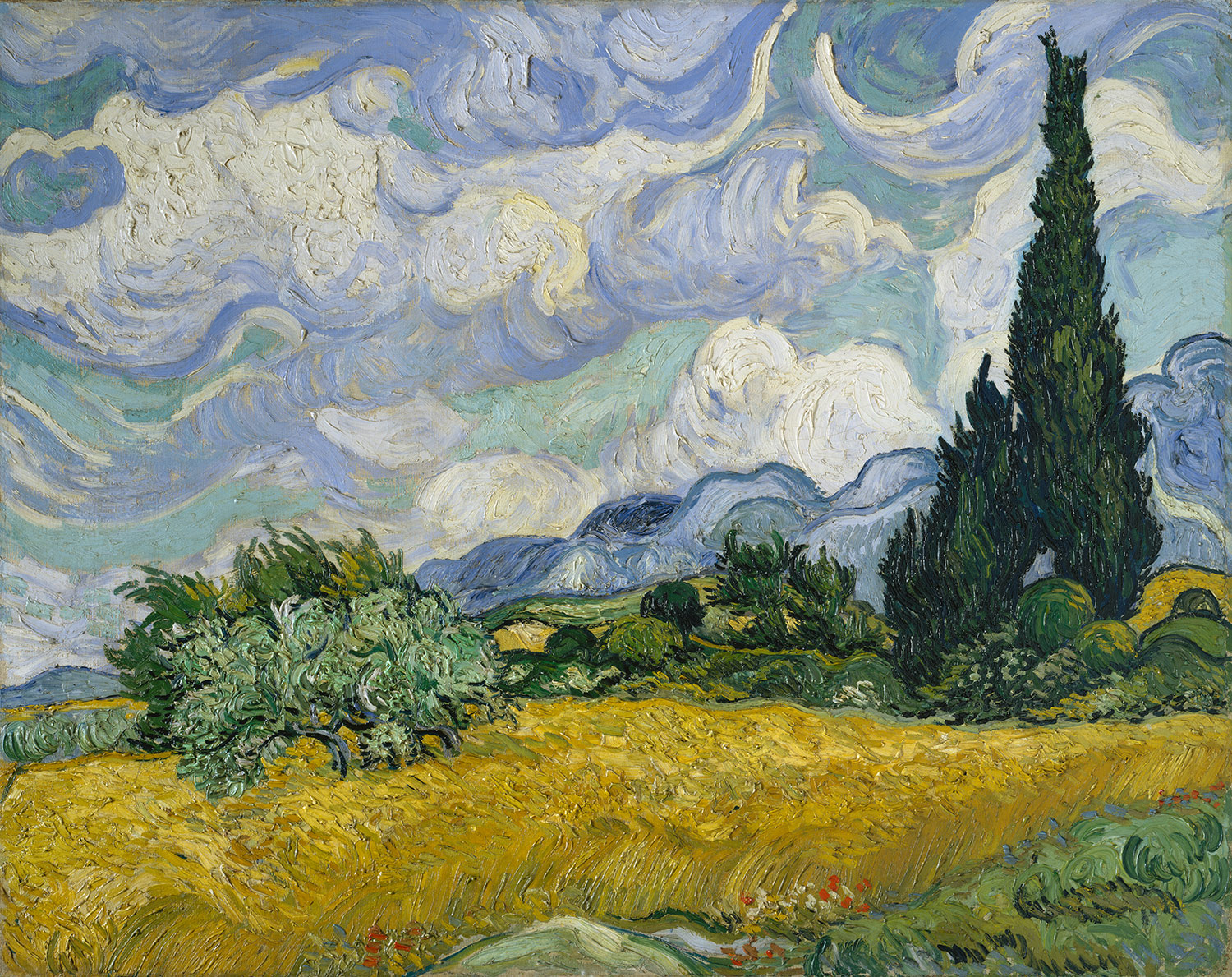
A Wheatfield, with Cypresses
A Van Gogh painting “‘A Wheatfield, with Cypresses’, painted in September 1889 has been brought to life through a living wall outside the National Gallery at Trafalgar Square.


See the original here

More than 8,000 plants of 26 varieties have been used to create the artwork. The painting will remain through out the English Summer and Autum until October 2011


Installed by specialist horticulture and design company ANS, Each plant was selected to match the original painting.


Watch for update vertical garden photos here
Patrick Blanc Dwell
http://www.dwell.com/outdoor/article/7-great-green-walls
7 Great Green Walls
OCTOBER 10, 2013
Not for the feint of heart, but for the green of thumb: A living wall is a vibrant way to celebrate nature in tandem with architecture. Peek through our archives for another look at living walls and vertical gardens.

Botanist Patrick Blanc designed this Paris aerie for the Dimanche family. Their indoor garden wall is 20 by 23 feet, dominating the living room in the best possible way. Photo by Jessica Antola.
Photo by
Originally appeared in Garden Apartment
Labels:
patrick blanc,
vertical garden,
vertical garden wall
Patric Blanc video
http://library.fora.tv/2011/02/10/Patrick_Blanc_The_Vertical_Garden
Patrick Blanc: The Vertical Garden from California Academy of Sciences on FORA.tv
kunststof ondergrond
pvc is niet erg umweltfreundlich
dioxine?
try EPDM
http://www.conservationtechnology.com/pond_liner_rubber.html
RUBBER POND LINERS
Pond liners made from synthetic rubbers are significantly more flexible and durable than liners made from plastics such as polyvinyl chloride (PVC), high-density polyethylene (HDPE), Polypropylene (PP), or thermoplastic polyolefin (TPO). Understanding the important differences between pond-grade rubbers and roofing rubbers and deciding what type of pond-grade rubber is best for each project requires a rudimentary understanding of how synthetic rubbers are made and how they differ.
SYNTHETIC RUBBER: A synthetic rubber is made by mixing one or more rubber polymers– the chemical backbones of rubbers responsible for their distinctive elastic properties– together with oils, carbon-black, sulfur, and other substances that provide the desired color, flexibility, strength, and hardness. This mixture passes between massive steel rollers which squeeze it into a thin sheet of uncured rubber. Since uncured rubber is very sticky, it must either be dusted with mineral talc (talc-process) or layered between sheets of fabric (talc-free process) so that it can be rolled up without sticking to itself and fusing into one solid mass. The roll is then baked in an oven until it chemically cures into the elastic substance we normally think of as rubber.
EPDM RUBBER: EPDM is the name given to the class of synthetic rubbers made primarily from EPDM polymer, shorthand for Ethylene Propylene Diene Monomer. Although there are hundreds of ways to formulate EPDM rubber from EPDM polymer, all share a chemical structure that gives them extraordinary resistance to heat, cold, sunlight, and air pollution. EPDM has been primarily used for waterproofing in exposed environments where long-term weatherability is essential, such as for waterproofing large flat roofs on commercial buildings. Since an EPDM rubber sheet can be formulated by combining as little as 30% of EPDM polymer with 70% of oils and fillers, it is relatively inexpensive to manufacture. As a consequence, EPDM rubbers are among the lowest priced of all synthetic rubbers.
EPDM RUBBER POND LINERS: The characteristics of an EPDM rubber sheet is determined both by the particular EPDM compound (mixture of ingredients) selected. Since any rubber made primarily of EPDM polymer can be called EPDM rubber, there are many types of EPDM and simply purchasing an EPDM sheet for use as a pond liner can be risky in the absence of information about the other ingredients which make up the majority of the formula. For example, certain curing compounds, fire-retardants, and fillers commonly used in EPDM roofing sheets rubber can be toxic to aquatic life. Pond-grade EPDM rubbers must be specially formulated and tested to be safe for plants, fish, and other aquatic life. We offer two pond-grade EPDM sheets: Pond EPDM and Conservation Technology EPDM, both of which have a long track record of safe use for pond lining.
POND LINER THICKNESS: Thickness of synthetic rubbers is expressed in mils: one mil equals one-thousandth of an inch or one-fortieth of a millimeter. In general, the thickness of rubber has little effect on environmental aging characteristics of a liner, but can have a significant effect on the ease of installation and resistance to mechanical abuse. Irregular free-form garden ponds, especially those smaller than 500 square feet, should be lined with 30 mil (0.75mm) rubber for the neatest results with the fewest folds. Larger free-form ponds, or small ponds with simple rectangular or elliptical shapes, can be successfully lined with 40 mil (1.0mm) or 45 mil (1.15 mm) rubber. Recreational ponds, stormwater ponds, irrigation reservoirs, canals, artificial wetlands, and other large projects are usually lined with 60 mil (1.5mm) rubber since it is easier to seam and is considerably stronger than thinner sheets. 60 mil sheet is also preferred for waterfalls and streams.
POND EPDM: Pond EPDM is our most popular and affordable EPDM rubber pond liner. It is manufactured with the talc process (see above) which leaves a mineral talc residue that gives it a slightly shiny surface: sheet color can vary from dark black to charcoal gray, depending on the amount of talc present. White streaks of talc may be present, but will usually disappear with time. Standard sizes in 45 mil thickness follow. Sizes shown in plain type are stock sizes that generally ship within 24 hours. Sizes in italics are not stock sizes and may involve shipping delays.
| 5 x 5 | ||||||||
| 5 x 10 | 10 x 10 | |||||||
| 5 x 15 | 10 x 15 | 15 x 15 | ||||||
| 5 x 20 | 10 x 20 | 15 x 20 | 20 x 20 | |||||
| 5 x 25 | 10 x 25 | 15 x 25 | 20 x 25 | 25 x 25 | ||||
| 5 x 30 | 10 x 30 | 15 x 30 | 20 x 30 | 25 x 30 | 30 x 30 | |||
| 5 x 35 | 10 x 35 | 15 x 35 | 20 x 35 | 25 x 35 | 30 x 35 | |||
| 5 x 40 | 10 x 40 | 15 x 40 | 20 x 40 | 25 x 40 | 30 x 40 | |||
| 5 x 50 | 10 x 50 | 15 x 50 | 20 x 50 | 25 x 50 | 30 x 50 | 35 x 50 | 40 x 50 | 50 x 50 |
| 5 x 100 | 10 x 100 | 15 x 100 | 20 x 100 | 25 x 100 | 30 x 100 | 35 x 100 | 40 x 100 | 50 x 100 |
| 5 x 150 | 10 x 150 | 15 x 150 | 20 x 150 | 25 x 150 | 30 x 150 | 35 x 150 | 40 x 150 | 50 x 150 |
| 5 x 200 | 10 x 200 | 15 x 200 | 20 x 200 | 25 x 200 | 30 x 200 | 35 x 200 | 40 x 200 | 50 x 200 |
For large water features and lakes we can generally supply the following non-stock roll sizes in 60 mil thickness:
| 10 x 100 | 20 x 100 | 30 x 100 | 40 x 100 | 50 x 100 |
CONSERVATION TECHNOLOGY EPDM: Conservation Technology EPDM Rubber is our highest quality EPDM pond liner. Its superior performance makes it the liner of choice for projects that demand the very best liner available. It is manufactured with the talc-free process (see above) that yields a clean, slightly textured black surface. We custom-fabricate 30 mil, 40 mil, and 60 mil sheets to order, so there are no standard sizes. In addition to simple rectangles, we can make almost any shape that can be drawn as a series of 5'6" strips of rubber (with certain length limitations), such as the following shapes:
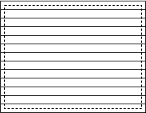 rectangle | 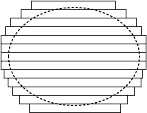 ellipse | 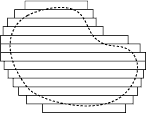 kidney |
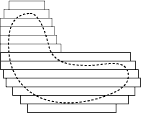 crescent | 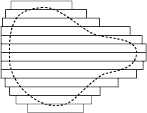 pear | 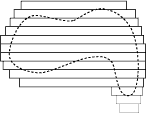 freeform |
CUSTOM THREE-DIMENSIONAL LINERS: Where folds are not acceptable, such as for formal reflecting ponds, we can fabricate three-dimensional rectangular liners with vulcanized corners in Conservation Technology EPDM Rubber. We can also fabricate three-dimensional L-shapes and cylinders, but these can be very expensive and may require long lead times. The walls of the pond must be accurately formed of wood, masonry, or concrete: three-dimensional liners cannot be used with soil or rustic stone walls. The liner can be fastened to the walls with our black metal termination bars and termination bar tapes, or it can be wrapped over the top as shown.
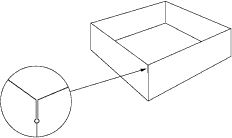
If the liner is to be wrapped over the top of the pond walls,
size the liner at least four inches taller than the pond.
Position the liner in place, and fill it partially with water.
Cut a small round hole at each corner of the pond walls
and slit the corners to make four side flaps.
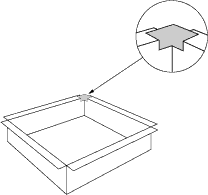
The open corners of the flaps can be sealed with a small square
of uncured repair tape. After the rubber is cleaned, the tape
is positioned so that it hangs over the pond approximately two inches.
Since the tape is stretchable, it can be formed into the corner.
FIELD SEAMS AND REPAIRS: Whenever possible, a pond should always be lined with a single sheet of rubber. Since sizes up to 50 ft x 200 ft are standard in Pond EPDM and even larger sizes are possible in Conservation Technology EPDM, field seaming in residential-scale work is usually limited to joining a stream or waterfall to a pond.
Larger projects such as recreational ponds and reservoirs will require field seaming several large sheets with a two-step process utilizing our self-adhesive seam tapes and laminates that are cold-applied without specialized equipment (see Seams). Note that we do not recommend the use of contact adhesives commonly used for rubber roofing, since these adhesives are too weak and have insufficient resistance to ponded water to be reliable for seaming pond liners. When we supply liners for a project requiring field seaming, our technical staff reviews all the details to make certain that the project can be successfully completed.
Holes can be permanently patched with our self-adhesive repair laminates; stream and waterfall liners can be easily joined to pond liners with our self-adhesive seam tapes (seeRepairs).
LIFETIME: Pond EPDM and Conservation Technology EPDM liners are warranted for twenty years, subject to certain limitations (request written warranty for details). Extensive field experience suggests that they will last longer than twenty years in severe above-ground environments and perhaps longer than fifty years in protected underwater or underground environments.
PACKING AND HANDLING: Pond EPDM liners 50 feet and longer are supplied accordion-folded and rolled; shorter liners are supplied accordion-folded and boxed. Stock 40 mil rolls are shipped on 7 foot cardboard cores; non-stock 40 mil rolls and 60 mil rolls are shipped on 11 ft long cardboard cores. All Pond EPDM liners are supplied boxed, accordion-folded in both directions. Both types of EPDM rubber weigh approximately 0.2 pounds per square foot in 30 mil thickness, 0.3 pounds per square foot in 40 mil or 45 mil thickness, and 0.4 pounds per square foot in 60 mil thickness.
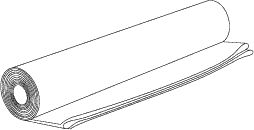 Pond EPDM 50 ft and longer is supplied accordion-folded in rolls. | 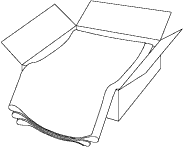 All other liners are supplied accordion-folded in boxes. |
When ordering a large liner, be prepared to get the roll or box off the delivery truck and get it to the site since the delivery company will not do this for you. Position the roll or box at one corner of the pond, either on the surrounding land or within the pond. Carefully remove the roll wrapper or open the box to see how the rubber is folded and then orient the roll or box in the proper direction. After checking the site to make certain there are no sharp objects that could snag the liner, unroll or unfold the liner into a long strip beside or into the pond and then pull the liner across the pond, flapping it slightly to force air under the liner to help it float into place.
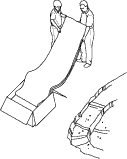 Unfold or unroll the liner, making a long strip beside or within the pond. | 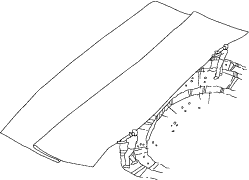 Then pull the liner across the pond, flapping it slightly to force air under the liner to help it float into place |
PRICING:
Pond EPDM Rubber Liners
45 mil Pond EPDM Liner, 5 ft x 5 ft - $18.00
45 mil Pond EPDM Liner, 5 ft x 10 ft - $36.00
45 mil Pond EPDM Liner, 5 ft x 15 ft - $54.00
45 mil Pond EPDM Liner, 5 ft x 20 ft - $72.00
45 mil Pond EPDM Liner, 5 ft x 25 ft - $90.00
45 mil Pond EPDM Liner, 5 ft x 30 ft - $108.00
45 mil Pond EPDM Liner, 5 ft x 35 ft - $126.00
45 mil Pond EPDM Liner, 5 ft x 40 ft - $144.00
45 mil Pond EPDM Liner, 5 ft x 45 ft - $162.00
45 mil Pond EPDM Liner, 5 ft x 50 ft - $180.00
45 mil Pond EPDM Liner, 5 ft x 100 ft - $360.00
45 mil Pond EPDM Liner, 10 ft x 10 ft - $72.00
45 mil Pond EPDM Liner, 10 ft x 15 ft - $108.00
45 mil Pond EPDM Liner, 10 ft x 20 ft - $144.00
45 mil Pond EPDM Liner, 10 ft x 25 ft - $180.00
45 mil Pond EPDM Liner, 10 ft x 30 ft - $216.00
45 mil Pond EPDM Liner, 10 ft x 35 ft - $252.00
45 mil Pond EPDM Liner, 10 ft x 40 ft - $288.00
45 mil Pond EPDM Liner, 10 ft x 45 ft - $324.00
45 mil Pond EPDM Liner, 10 ft x 50 ft - $360.00
45 mil Pond EPDM Liner, 10 ft x 100 ft - $720.00
45 mil Pond EPDM Liner, 15 ft x 15 ft - $162.00
45 mil Pond EPDM Liner, 15 ft x 20 ft - $216.00
45 mil Pond EPDM Liner, 15 ft x 25 ft - $270.00
45 mil Pond EPDM Liner, 15 ft x 30 ft - $324.00
45 mil Pond EPDM Liner, 15 ft x 35 ft - $378.00
45 mil Pond EPDM Liner, 15 ft x 40 ft - $432.00
45 mil Pond EPDM Liner, 15 ft x 45 ft - $486.00
45 mil Pond EPDM Liner, 15 ft x 50 ft - $540.00
45 mil Pond EPDM Liner, 15 ft x 100 ft - $1080.00
45 mil Pond EPDM Liner, 20 ft x 20 ft - $288.00
45 mil Pond EPDM Liner, 20 ft x 25 ft - $360.00
45 mil Pond EPDM Liner, 20 ft x 30 ft - $432.00
45 mil Pond EPDM Liner, 20 ft x 35 ft - $504.00
45 mil Pond EPDM Liner, 20 ft x 40 ft - $576.00
45 mil Pond EPDM Liner, 20 ft x 45 ft - $648.00
45 mil Pond EPDM Liner, 20 ft x 50 ft - $720.00
45 mil Pond EPDM Liner, 20 ft x 50 ft - $1440.00
45 mil Pond EPDM Liner, 25 ft x 25 ft - $450.00
45 mil Pond EPDM Liner, 25 ft x 30 ft - $540.00
45 mil Pond EPDM Liner, 25 ft x 35 ft - $630.00
45 mil Pond EPDM Liner, 25 ft x 40 ft - $720.00
45 mil Pond EPDM Liner, 25 ft x 45 ft - $810.00
45 mil Pond EPDM Liner, 25 ft x 50 ft - $900.00
45 mil Pond EPDM Liner, 30 ft x 30 ft - $648.00
45 mil Pond EPDM Liner, 30 ft x 35 ft - $756.00
45 mil Pond EPDM Liner, 30 ft x 40 ft - $864.00
45 mil Pond EPDM Liner, 30 ft x 45 ft - $972.00
45 mil Pond EPDM Liner, 30 ft x 50 ft - $1080.00
other sizes in 45 mil or 60 mil - $call
45 mil Pond EPDM Liner, 5 ft x 5 ft - $18.00
45 mil Pond EPDM Liner, 5 ft x 10 ft - $36.00
45 mil Pond EPDM Liner, 5 ft x 15 ft - $54.00
45 mil Pond EPDM Liner, 5 ft x 20 ft - $72.00
45 mil Pond EPDM Liner, 5 ft x 25 ft - $90.00
45 mil Pond EPDM Liner, 5 ft x 30 ft - $108.00
45 mil Pond EPDM Liner, 5 ft x 35 ft - $126.00
45 mil Pond EPDM Liner, 5 ft x 40 ft - $144.00
45 mil Pond EPDM Liner, 5 ft x 45 ft - $162.00
45 mil Pond EPDM Liner, 5 ft x 50 ft - $180.00
45 mil Pond EPDM Liner, 5 ft x 100 ft - $360.00
45 mil Pond EPDM Liner, 10 ft x 10 ft - $72.00
45 mil Pond EPDM Liner, 10 ft x 15 ft - $108.00
45 mil Pond EPDM Liner, 10 ft x 20 ft - $144.00
45 mil Pond EPDM Liner, 10 ft x 25 ft - $180.00
45 mil Pond EPDM Liner, 10 ft x 30 ft - $216.00
45 mil Pond EPDM Liner, 10 ft x 35 ft - $252.00
45 mil Pond EPDM Liner, 10 ft x 40 ft - $288.00
45 mil Pond EPDM Liner, 10 ft x 45 ft - $324.00
45 mil Pond EPDM Liner, 10 ft x 50 ft - $360.00
45 mil Pond EPDM Liner, 10 ft x 100 ft - $720.00
45 mil Pond EPDM Liner, 15 ft x 15 ft - $162.00
45 mil Pond EPDM Liner, 15 ft x 20 ft - $216.00
45 mil Pond EPDM Liner, 15 ft x 25 ft - $270.00
45 mil Pond EPDM Liner, 15 ft x 30 ft - $324.00
45 mil Pond EPDM Liner, 15 ft x 35 ft - $378.00
45 mil Pond EPDM Liner, 15 ft x 40 ft - $432.00
45 mil Pond EPDM Liner, 15 ft x 45 ft - $486.00
45 mil Pond EPDM Liner, 15 ft x 50 ft - $540.00
45 mil Pond EPDM Liner, 15 ft x 100 ft - $1080.00
45 mil Pond EPDM Liner, 20 ft x 20 ft - $288.00
45 mil Pond EPDM Liner, 20 ft x 25 ft - $360.00
45 mil Pond EPDM Liner, 20 ft x 30 ft - $432.00
45 mil Pond EPDM Liner, 20 ft x 35 ft - $504.00
45 mil Pond EPDM Liner, 20 ft x 40 ft - $576.00
45 mil Pond EPDM Liner, 20 ft x 45 ft - $648.00
45 mil Pond EPDM Liner, 20 ft x 50 ft - $720.00
45 mil Pond EPDM Liner, 20 ft x 50 ft - $1440.00
45 mil Pond EPDM Liner, 25 ft x 25 ft - $450.00
45 mil Pond EPDM Liner, 25 ft x 30 ft - $540.00
45 mil Pond EPDM Liner, 25 ft x 35 ft - $630.00
45 mil Pond EPDM Liner, 25 ft x 40 ft - $720.00
45 mil Pond EPDM Liner, 25 ft x 45 ft - $810.00
45 mil Pond EPDM Liner, 25 ft x 50 ft - $900.00
45 mil Pond EPDM Liner, 30 ft x 30 ft - $648.00
45 mil Pond EPDM Liner, 30 ft x 35 ft - $756.00
45 mil Pond EPDM Liner, 30 ft x 40 ft - $864.00
45 mil Pond EPDM Liner, 30 ft x 45 ft - $972.00
45 mil Pond EPDM Liner, 30 ft x 50 ft - $1080.00
other sizes in 45 mil or 60 mil - $call
Conservation Technology Rubber Liners
30 mil Conservation Technology Pond Liner, 5.5 ft x 82 ft - $call
30 mil Conservation Technology Pond Liner, 5.5 ft wide, per foot - $call
40 mil Conservation Technology Pond Liner, 5.5 ft x 82 ft - $call
40 mil Conservation Technology Pond Liner, 5.5 ft wide, per foot - $call
60 mil Conservation Technology Pond Liner, 5.5 ft x 82 ft - $call
60 mil Conservation Technology Pond Liner, 5.5 ft wide, per foot - $call
pre-fabricated sizes in 30 mil, 40 mil, or 60 mil - $call
30 mil Conservation Technology Pond Liner, 5.5 ft x 82 ft - $call
30 mil Conservation Technology Pond Liner, 5.5 ft wide, per foot - $call
40 mil Conservation Technology Pond Liner, 5.5 ft x 82 ft - $call
40 mil Conservation Technology Pond Liner, 5.5 ft wide, per foot - $call
60 mil Conservation Technology Pond Liner, 5.5 ft x 82 ft - $call
60 mil Conservation Technology Pond Liner, 5.5 ft wide, per foot - $call
pre-fabricated sizes in 30 mil, 40 mil, or 60 mil - $call
Labels:
how to,
plants,
tools,
vertical garden wall
Patrick Blanc London The Driver & Mur Vegetal at The Atheneum
https://hotspotting.wordpress.com/2009/09/11/sneaky-snapshots/




Sneaky snapshots
11092009
I finally got up close and personal with Patrick Blanc’s creations – firstly the vertical garden at The Driver and then the Mur-Vegetal at The Athenaeum!
I’ve taken some great close-up pics of the plants and structure and hope it helps all you aspiring vertical gardeners…
I’ve taken some great close-up pics of the plants and structure and hope it helps all you aspiring vertical gardeners…
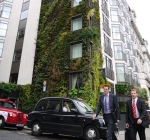 | 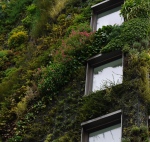 |  |
Although The Driver looks great from the outside, there’s no way of appreciating the wall up-close. Although they have a roof-terrace, it’s not in view of the wall. This is annoying for two reasons –
- I couldn’t take pictures (not good for us!)
- You only get to appreciate the wall when you’re NOT a customer (not good for the people who own The Driver!)
The following photos are therefore taken of The Athenaeum hotel near Hyde Park…

The effect of the huge swathes of plant-life comes from having lots of small plants grouped together.


Patrick Blanc uses a felt layer stapled onto a 1cm thick pvc sheet which is attached to a metal frame. The felt shown above looks really recent as once the wall is established the felt layer discolours as it’s constantly moist from soaking up the water and delivering to the plants and other parts of the felt.

I’m not a felt expert but it looks like regular felt!
On closer inspection you can see that there is a really thin layer of plastic behind the felt. I’m not sure if this is behind the entire felt cover as surely that would affect the water-absorption? Maybe it’s for strength or just to contain part of the rootball?
The intention is that the plants will use the felt instead of soil, although when peering inside one of the pouches i could see a small amount of soil. This soil maybe from when the plant was transferred into the structure as Patrick says on his website that plants can either be from seed, cutting or already grown.

The felt allows the water to be soaked up and distributed. The wall is kept constantly moist – as can be seen from the picture above – it was dripping continuously. That water is then filtered and re-circulated through the arrangement.

I believe there is an elaborate piping system behind the felt and plastic layers. There seems to be two main vertical pipes in the picture above and at least one horizontal just in the above section.
This picture is of the top of a window. I believe the silver container on the top left collects the drips and the pipe then connects this to the rest of the network. As you can see the pipes are intended to be hidden so as not to distract from the display.
The great thing about the felt is that over time it gets its own plant-life growing on it – moss, lichen etc and that greenery fills in the gaps where the plants may not have quite reached.
I recommend you go see Patrick Blanc’s creation at The Athenaeum hotel. The wall goes all the way down to ground level so you can get right up close to it and plan your own vertical garden!
Abonneren op:
Posts (Atom)




